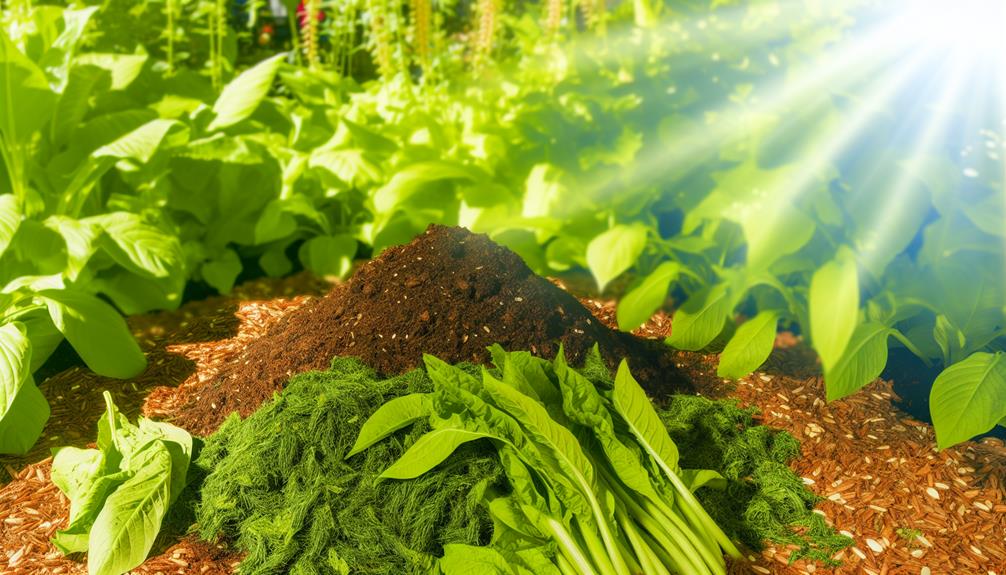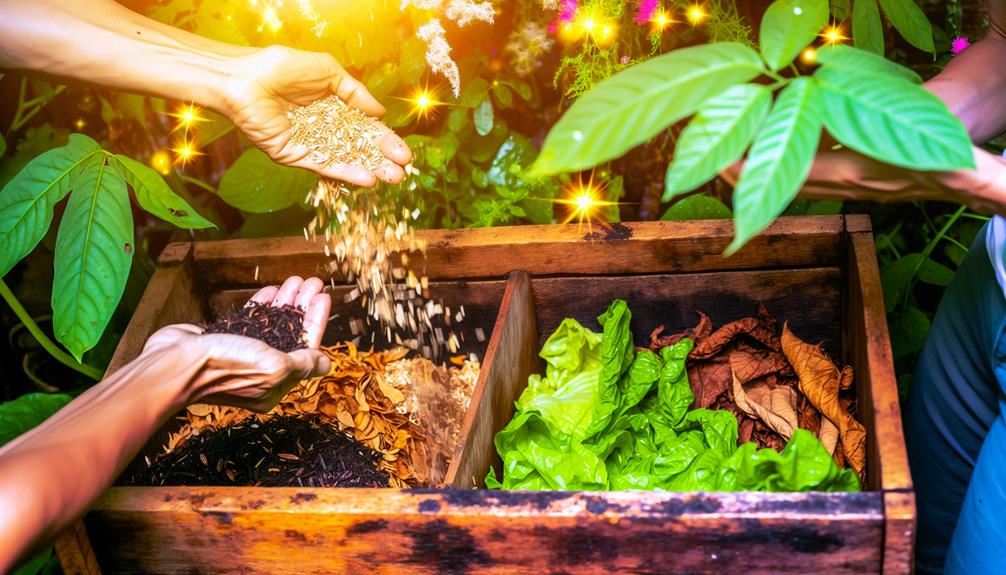

You can definitely compost spent grain to enrich your soil and reduce waste. Start by drying the spent grain to reduce its high moisture content, aiming for less than 10%. Mix it with green materials like kitchen scraps and brown materials like leaves to balance the carbon-to-nitrogen ratio.
Turn your compost pile weekly for aeration, and manage odors by adding more browns if necessary. This compost will boost microbial activity in your soil, leading to improved plant health and growth. Keep learning to discover more ways spent grain can benefit your garden and the environment.
By composting spent grain, you can enrich your soil with valuable nutrients and reduce waste. This practice not only benefits your garden but also contributes to broader environmental goals. You’ll be taking a significant step towards waste reduction by diverting spent grain from landfills, where it would otherwise contribute to methane emissions and other environmental issues.
Composting spent grain is straightforward. Start by mixing it with other compostable materials like leaves, grass clippings, and kitchen scraps. This blend guarantees a balanced compost pile that breaks down efficiently. The environmental benefits are clear: you’re recycling organic material and reducing your carbon footprint. This act of sustainability can also foster a sense of community among like-minded individuals who share your passion for environmentally friendly practices.
Make sure to turn your compost pile regularly to aerate it and speed up the decomposition process. The result will be a rich, dark compost teeming with life-giving nutrients ready to enhance your garden soil.
Also Read: Can You Compost Cactus?
Understanding the nutrient profile of spent grain will help you maximize its benefits in your composting efforts. Spent grain, a byproduct of brewing, is rich in nutrients that can enhance your compost. One of the standout components is its high protein content. Typically, spent grain contains around 20-30% protein. This makes it an excellent addition to your compost pile, providing essential nitrogen that aids in the decomposition process and enriches the final compost.
In addition to protein, spent grain boasts a significant fiber composition. The fiber, primarily in the form of cellulose and hemicellulose, contributes to the bulk of your compost. This fibrous material helps improve the structure and aeration of the compost, which is important for microbial activity and efficient breakdown of organic matter.
When you add spent grain to your compost, you’re also introducing other essential nutrients like phosphorus, potassium, and trace minerals. These elements further enhance the nutrient profile of your compost, making it more beneficial for your garden.
To prepare spent grain for composting, start by drying it to reduce moisture and prevent mold. Spread the grain out in a thin layer and let it air dry for a few days, stirring occasionally.

Once dry, mix the spent grain with green materials like kitchen scraps or grass clippings to balance the carbon-to-nitrogen ratio.
Drying spent grain thoroughly is essential to prevent mold and guarantee it composts efficiently. To get started, explore different drying methods to make sure you reduce the moisture content adequately. One effective approach is laying the grain out in a thin layer on a tarp or baking sheet in a dry, well-ventilated area.
If you have a dehydrator, that’s another excellent option; simply spread the grains evenly and allow the machine to do its work.
Checking the moisture content is important. You want the grains to feel dry to the touch, similar to dry oats. If they clump together, they’re still too wet. A good rule of thumb is to aim for a moisture content of less than 10%.
This ensures that the grains won’t invite mold or other unwanted organisms into your compost bin.
Combining dried spent grain with green materials creates a balanced compost mixture that decomposes efficiently. To get started, you’ll need to focus on the carbon ratio and moisture content.
Spent grains are rich in nitrogen, making them a ‘green’ component. To balance this, mix them with ‘brown’ materials like dried leaves, straw, or cardboard, which are high in carbon. Aim for a carbon to nitrogen ratio of about 30:1 for best composting results.
Next, consider the moisture content. Spent grains can be quite wet, so if they’re not dried properly, they’ll need additional dry materials to prevent your compost from becoming too soggy. A moisture content of 40-60% is ideal. If your compost pile feels too wet, add more brown materials to absorb excess moisture. Conversely, if it’s too dry, sprinkle some water or add more green materials.
Layering is key. Start with a layer of brown, then a layer of green with spent grain, and continue alternating. Turn your pile weekly to aerate it, which speeds up decomposition.
Also Read: Can You Compost Cat Feces?
Achieving the proper balance in your compost pile is crucial for efficient decomposition and nutrient-rich compost. To guarantee success, you need to maintain a proper carbon ratio. This involves balancing carbon-rich materials like dry leaves, straw, and cardboard (often referred to as ‘browns’) with nitrogen-rich materials such as kitchen scraps, grass clippings, and spent grain (‘greens’). A recommended carbon-to-nitrogen ratio is about 30:1.
Pile aeration is another essential factor. Proper aeration helps oxygen reach the microorganisms that break down organic matter. To achieve this, turn your compost pile regularly—about once a week. This simple act of mixing not only introduces oxygen but also helps evenly distribute moisture and heat, promoting faster decomposition.
Incorporate your spent grain into the compost by mixing it with browns. If you add too much spent grain at once, it might compact and limit airflow, leading to anaerobic conditions. So, layer it thoughtfully, ensuring there’s ample brown material to maintain the balance.
Also Read: Can You Compost Cat Food?
When problems arise in your compost pile, quick identification and resolution are key to maintaining a healthy decomposition process. If you’ve noticed a strong odor, excessive insects, or other issues, don’t worry—these are common and fixable problems.

To manage odors, guarantee your compost has the right balance of green and brown materials. Spent grain is high in nitrogen (green), so mix it with carbon-rich materials like leaves or straw. Also, turn the pile regularly to aerate it and prevent anaerobic conditions that cause bad smells.
For insect control, cover your compost with a layer of soil or brown materials to deter pests. Avoid adding meat or dairy products, as these attract unwanted critters.
Here are some common issues and solutions:
Also Read: Can You Compost Cat Manure?
Using your compost in the garden can greatly enrich soil nutrients and boost plant growth.
Spread a layer of compost around your plants to improve soil structure and water retention.
You’ll notice healthier, more robust plants, thanks to the nutrient boost from the spent grain compost.
Incorporating composted spent grain into your garden soil greatly enhances its nutrient content, promoting healthier plant growth. When you mix this compost into your soil, you’re not just adding organic matter; you’re also improving soil aeration and boosting microbial activity. These changes create an ideal environment for your plants to thrive.
Here’s why using spent grain compost can be a game-changer for your garden:
When you add spent grain compost, you foster a sense of community within your garden. The beneficial microbes work together to decompose organic matter, creating a rich, fertile soil that supports vibrant plant life. This not only benefits your plants but also contributes to a healthier garden ecosystem.
Also Read: Can You Compost Cabbage?
To boost plant growth, mix the composted spent grain directly into the topsoil around your garden. This enriches the soil with essential nutrients, enhancing plant health. Partnering with local breweries can provide a steady supply of spent grain, turning waste into a valuable resource for your garden.
Consider these benefits of using composted spent grain:
| Benefit | Description | Tip for Gardeners |
|---|---|---|
| Nutrient-Rich Soil | Spent grain adds nitrogen, phosphorus, and potassium. | Mix thoroughly to avoid hot spots. |
| Improved Texture | Enhances soil structure, promoting root development. | Combine with other organic matter. |
| Water Retention | Helps soil retain moisture, reducing watering needs. | Monitor soil moisture levels regularly. |
| Sustainable Practice | Reduces waste through eco-friendly recycling. | Engage with local brewery partnerships. |
| Cost-Effective | Low-cost alternative to commercial fertilizers. | Collect spent grains regularly. |
Incorporating spent grain compost offers alternative uses beyond waste management. It’s a sustainable way to enrich your garden, making it more resilient and productive. Engage with breweries in your community to create a continuous loop of sustainability. Remember, consistency is key—regularly adding compost ensures ongoing benefits for your plants.
Yes, spent grain can attract pests to your compost pile. For effective pest control, always use a compost cover. This will help maintain a balanced, pest-free environment, making your composting efforts successful and your community proud.
Spent grain’s decomposition rate depends on moisture levels. Keep it moist, and it should break down in a few months. You’re part of a community that values sustainability, so your efforts here make a real difference.
You can compost spent grain even if it’s moldy, but focus on mold prevention and compost hygiene. Mix it well with other materials to avoid unpleasant odors and maintain a healthy, balanced compost pile for community gardens.
You can use spent grain as animal feed, which supports sustainable farming. Alternatively, try incorporating it as baking ingredients in breads and cookies. These uses foster community and shared passion for sustainability and delicious recipes.
When you compost spent grain, you’ll notice a fermentation odor due to the breakdown process. Aerobic digestion can help minimize the smell. Joining a community of composters can provide tips to manage and reduce any unpleasant odors.
Composting spent grain is a practical way to enrich your garden soil. Make sure you prepare the grain properly and balance your compost pile with the right mix of greens and browns.
Keep an eye on moisture levels to avoid common issues like odor or mold. With these steps, you’ll create nutrient-rich compost that boosts plant health.
Incorporate this compost into your garden, and you’ll notice improved soil structure and healthier plants.
